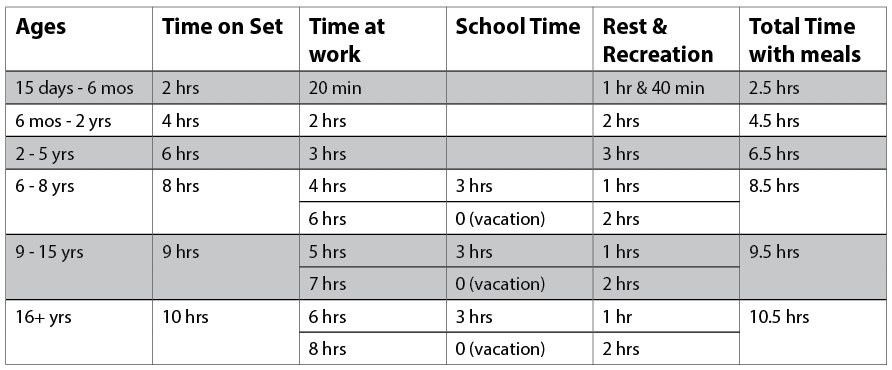Working with Actors
SAG/Non-SAG
The Non-SAG Route
Sometimes it will seem much easier and less complicated to have your production be non-SAG. By far, the majority of CalArts productions go down this route. But there are certain things to keep in mind working non-union: will the talent of non-union actors bring your story to life the way you envision it? Will the fact that the actors are non-professionals add extra time to your set? So be aware and plan into your production schedule the extra time that it may take to deal with non-professionals in pre-production and on-set. Time management is the most important part of any production, and thinking ahead is crucial to success. Understanding the personalities, wants, and desires of those you work with can sometimes be the difference between success and failure.
The Flip Side is Interesting
- No SAG paperwork and locked-in time constraints.
- You do not have to follow every SAG rule.
- Sometimes student productions do not warrant the use of SAG actors.
- As CalArts does not have a direct agreement with the SAG that allows their members to work on student films, you must make arrangements directly with SAG.
Working with SAG
All productions that work with SAG must be approved and become a signatory of SAG. Many CalArts thesis productions decide to go this route. Some benefits include working with professional actors who do this for a living, learning to work within a structure that will benefit you as a student as well as in your professional career, and networking with professional actors to start building a group of collaborators with whom you enjoy working with and trust.
Remember SAG asks for paperwork to be submitted two weeks prior to the start of production.
The Student SAG Agreement vs The Micro-Budget Project Agreement
It is recommended that students use the Micro-Budget Project Agreement if their budget is under $20,000. This contract has fewer limitations on distribution and paying into pension and health. This SAG contact is recommended. More information on the Micro-Budget Project Agreement can be found at https://www.sagaftra.org/production-center/contract/968/getting-started
The following is the student agreement information page as it appears on the SAG website. To access all the required information and start your process, please go to: sagaftra.org/production-center/contract/817/all-forms/document and click on Producer’s Guide to Working with SAG-AFTRA on a Student Film. Remember that Production Services is here to help you through this process.
Student Film Signatory Instructions
Producer’s Guide to Working with SAG-AFTRA on a Student Film
SAG-AFTRA Signatory Producers have access to the worlds most talented and professional performers for their projects, but becoming signatory does require completing a small amount of paperwork. We understand that dealing with paperwork isn’t as much fun as shooting your project, so to ease this burden we’ve created this simple 3-step guide to completing the signatory process.
Documents
The Signatory Package Zip Files that are posted on the Production Center at SAGAFTRA.org are provided so that producers may review and consider them before beginning the signatory process. They are for demonstration purposes only—documents with signature lines are watermarked “SAMPLE” and cannot be executed.
For your reference, the Signatory Package Zip Files are divided into 2 folders: Signatory Documents and Production Documents. You will use the Signatory Documents to sign with the union, and the Production Documents to manage the production and post- production phases of your project. Once you have decided to begin the signatory process, start by following the steps outlined in the Pre-Production section below.
Step 1 – Pre-Production
Unless you have already done so, begin by filling out a copy of the Preliminary Information Sheet Student Short Film 4.23 . Return this form along with a copy of the script and a copy of your driver’s license, via e-mail to: signyourfilm@sag.org, or by fax at (323) 549-6886. You may also mail these items to us at: SAG-AFTRA, Theatrical Contracts, 5757 Wilshire Blvd., 7th Floor, Los Angeles, CA 90036.
The Zip File that the SAG-AFTRA Business Representative will electronically forward to you includes a copy of the Student Film Agreement 1.11 along with a Pre-Production Cast List 5.1. Those documents are not samples and can be fully executed. All you need to do is:
– Open the PDF and fill in all of the writeable fields (highlighted in light blue). It is important that you do not leave any fields blank, because an incomplete form may cause delays in processing.
– Sign on the “Producer/Legally Responsible Party” line at the bottom of the form. The name of the person signing should match the name on the driver’s license you originally forwarded to SAG with your Preliminary Information Sheet.
– Your instructor (Production Services) must complete and sign the statement at the bottom of the Student Film Agreement 1.11.
– Return a hand-signed original copy and the completed Pre-Production Cast List 5.1 via overnight delivery, or hand deliver to the attention of your SAG-AFTRA Business Representative at: SAG-AFTRA, Theatrical Contracts, 5757 Wilshire Blvd., 7th Floor, Los Angeles, CA 90036.
When all of the requirements outlined above are fulfilled, your Business Representative will give your production “clearance,” which will allow the performers you have cast to begin work.
Important Notice Regarding Signatory Documents: Who may sign?
Signatory documents must be executed by an authorized person or persons.
– Corporations – Any person who is authorized by the President or Secretary of the Corporation on the Corporate Resolution. The Corporate Resolution may be signed only by the President or Secretary of the Corporation.
– Limited Liability Corporations – The Manager or Managing Member as indicated by the Articles of Organization, the Operating Agreement and authorized by the Limited Liability Company Resolution.
– Limited Partnerships – The General Partner as identified in the Partnership Agreement.
– Sole Proprietorships – The Individual Owner.
– D/B/A (“Doing Business As”) – The Individual.
Step 2 – Production
Complete the following documents during production:
– Each professional performer must sign a Performer Contract Student Film 6.34.
– Each professional performer must sign a Performer Confirmation Of Receipt Of Contracts Student Short Film 6.13.
– Complete a Production Time Report Exhibit G 6.14 for each day of production.
– Complete Final Cast List Information Sheet 7.1 at the end of production.
Step 3 – Post-Production
Send the following documents to the attention of your SAG-AFTRA Business Representative:
– Copies of each Performer Contract Student Film 6.34, signed by the performer. Include, if applicable, all performer deal memos, side letters, etc.
– All completed Production Time Report Exhibit G 6.14 forms.
– All Performer Confirmation Of Receipt Of Contracts Student Short Film 6.13 forms, signed by the performers.
– Final Cast List Information Sheet 7.1
That’s it! If you have any questions, please contact your SAG-AFTRA Business Representative
Working With Minors
General Rules
California Child Labor Laws are very strict and do not provide exemptions for student films. When children are present on a set, they are considered to be at work and the labor laws are designed to protect them. California regulations apply to minors (under age 18) who work in California or who are taken out of state to work. They also apply to minors from out-of-state who work in California.
Any project that uses a minor must adhere to California labor laws. This includes getting a permit to employ a minor, only using a minor who has a permit to work, and hiring a studio teacher.
The work hours of minors are strictly regulated and vigorously enforced. Young children have shorter attention spans than adults, and they tire quickly. The number of hours a child may work is determined by age. Extension of these hours is not allowed. There are penalties for violation.
The State of California requires that an objective, third party must be present when a child is working—a person whose sole concern is to safeguard the welfare of the minor. These are commonly called “Studio Teachers.” See next section for details.
Studio Teacher
A Studio Teacher in California is a credentialed secondary teacher who has been certified by the Labor Commissioner. A certified Studio Teacher must be present whenever a minor is working. In addition, the legal guardian or parent of the minor must be present the entire time the child is working and within sight and sound of the child. Relatives, neighbors or babysitters are not legal substitutes, even if they have written permission from the parent or legal guardian.
In California, a Studio Teacher is responsible, by law, for the health, safety and moral well- being of the child or children working on the film. The term “welfare worker” is sometimes used and is more appropriate. A Studio Teacher has the absolute discretion to remove a minor from a production if the teacher feels that the health, safety and/or moral well being of the minor(s) may be compromised. The Studio Teacher is required even when school is not in session, including weekends.
Minors 16 years of age and older only need Studio Teachers if schooling is required. (Schooling is not required on weekends and during the summer.)
Minors must have a permit to work before they can be employed. They must bring the permit to the set with them each day they work. Studio Teachers will want to see these permits before they allow a child to work on a film. It is the responsibility of the minor’s parents to obtain this permit. Be sure to ask whether the child has a permit to work when casting a film.
Filmmakers/students/employers of minors must also have a permit to employ when working with minors. Studio Teachers want to see the permit to employ before they allow filming to begin. These permits are also required for minors making voice recordings or who are employed as advertising or photographic models for photography or advertising. Permits are required even when the entertainment is noncommercial in nature. It is important to note that Workers Compensation Insurance is required to be issued a permit to employ minors. Permits to employ are free.
If you are working with an infant who is 15 days to six months of age, you must also have a nurse present on the set. You must provide an “adequate facility” removed from the work site where the baby can eat and/or sleep without being held. An infant of this age cannot be at the place of employment for more than 2 hours or work for more than 20 minutes. An infant cannot be exposed to light of greater intensity than 100 foot-candles for more than 30 seconds at a time. The use of infants younger than fifteen days is not allowed.
Work Hours for Minors
The work hours of minors are strictly regulated and vigorously enforced. The number of hours a child may work is determined by the age of that child. Extension of these hours is not allowed. There are penalties for violation. Rehearsal counts as work time.

- No more than 8 hours in one day of 24 hours.
- No more than 48 hours in one (1) week.
- No earlier than 5:00 am.
- No later than 10:00 pm on the evening preceding the school day.
- No later than 12:30 am on an evening preceding a non-school day.
Permits for students to work with minors can be obtained at:
Department of Labor Standards Enforcement
6150 Van Nuys Blvd.
Van Nuys, CA 91401
(818) 901-5484
Online form: www.dir.ca.gov/dlse/DLSE-Forms-CL.htm
State Law
The requirements established for the use of minors in motion picture and television production are California State law. Failure to comply with these laws could result in criminal and/or civil penalties for not only the producer and director, but other participants in the production as well. No one has the authority to “waive” the Studio Teacher requirement.
